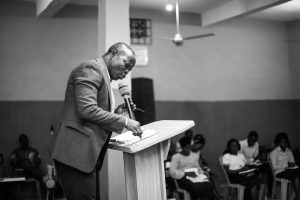Part 1
Luke’s continuation of his historical sketch of the early Christian movement expands in the book of Acts. In our previous posts, we considered how Luke’s Gospel set forth the practice of our Lord in training leaders who would pastor, plant, and revitalize churches. But leadership development from the congregational angle did not stop with Jesus and his work with the Twelve and the Seventy. Luke’s writing in Acts helps us to understand that local congregations developed and spread as new leaders stepped up to the challenge of the Great Commission.
From the second century onward, the church recognized the Lukan authorship of Acts. Irenaeus (A.D.
120–202) noted Luke’s partnership with Paul and his personal involvement in many details that he records, calling him “not merely a follower, but also a fellow-labourer of the apostles, but especially of Paul.” Eusebius (c. A.D. 260–340), while testifying to Luke’s authorship of his Gospel and Acts, mentions his birth in Antioch where the expansive missionary movement to the Gentile world originated. The observations by these church fathers prove helpful in understanding Luke’s missiological and leadership development insights. Luke’s perspective as historian and participant in the early mission of the church yields rich insights on the perpetuation of Great Commission work. He shows that gospel work and church planting requires faithful leadership.
The Acts of the Apostles distinguishes from Luke’s Gospel Jesus’ earthly activity, and his work as reigning Lord of the Church through Spirit-empowered messengers. Luke demonstrates that the “disciple is not above his master” (Matt 10:24) in the need to persevere in advancing the kingdom through suffering and proclamation. While leadership development was certainly not the theme of Luke’s work, he addressed varied angles of it by giving ample illustration of the “breathtaking choice of God” to use weak, flawed vessels to accomplish his work. “Biblically,” writes Timothy Laniak, “leadership can only be understood in terms of a fully integrated theological vision of God and his work on earth.” So, Luke writes theological-history, not conforming to modern critical historical standards but utilizing historical standards common in antiquity, thus offering a theological look at his historical recounting.
Since the Acts narrative chronicles the emergence of new churches and leaders who planted and shaped them, Acts gives contours of leadership by presuming leadership development rather than explaining it. However, although not stated in precept, leadership development shows up in practice. For instance, “If they have called the head of the house Beelzebul, how much more will they malign the members of his
household” (Matt 10:24–25). Jesus declared that leaders of his church would face opposition similar to his own. The post-Pentecost experiences of early church leaders amply proved this by the malignant opposition of religious and civil leaders in Jerusalem and beyond (Acts 4:1–22; 5:17–42; 7:54–8:3; 13:44–52; 14:19; 16:16–24; 17:5–9, 13; 19:23–41). Thus Paul and Barnabas had no hesitation to instruct the Galatian churches, “Through many tribulations we must enter the kingdom of God” (Acts 14:22). It is no surprise that in the very next statement Luke refers to the appointment of elders in each of the churches, since often the brunt of tribulation fell upon church leaders (Acts 14:23; e.g. Acts 17:6–9).
Martin Hengel suggested that small Jewish-Christian communities developed outside Galilee in the adjacent Phoenician coast due to the work of Jesus and those he earlier sent out (Luke 9:1–9; 10:1–20). This development prepared the way for the later Hellenistic Jewish Christians who were bolder in their faith and more missionary in their spirit, to evangelize and plant churches when scattered from Jerusalem due to the persecution that arose over Stephen (Acts 11:19; 15:3). Thus Luke connects the exercise of leadership in planting and encouraging churches to both his Gospel and Acts.
Although Peter and Paul served as the primary actors in Luke’s narrative, the balance of his story suggests that these two apostolic giants did not plant and strengthen churches alone. In some cases, Luke identifies other players in the unfolding mission of the church; in others, he only mentions the work in passing without naming the particular leaders responsible for establishing the new Christian communities (e.g. Acts 9:31; 15:3; 21:3–14). Who were the leaders planting and revitalizing early churches? Who trained them for their responsibilities? What spurred them toward faithful mission in the face of opposition? The next few posts that I will offer (D.V.) will seek to investigate early signs of leadership training in Acts (July 29), the role of the scattered saints in church planting (August 15), and the mission of Paul and his partners (September 3).
Just as with the previous considerations in Luke’s Gospel, the same hermeneutical position will be followed when considering the book of Acts. For instance, Paul’s practice of celibacy as a missionary of the gospel does not prescribe celibacy for all future missionaries, nor do his journeys by land or by ship require that future missionaries adopt his method of travel. No evidence is given in the epistles or succeeding generations that these were normative requirements for future leaders. On the other hand, Jesus’ decision to formally set apart the Twelve from those who followed him to extend his work authoritatively indicates prescriptive practice (not of the precise number “twelve” but of a narrower group of designated leaders from the larger body of followers) later found in Acts 6:6; 13:3; 1 Tim 4:14; 5:22; 2 Tim 1:6; and in succeeding generations of the church. This formal practice continues in our own day. Those practices adopted by the apostolic leaders in Acts and continued in the epistles and succeeding generations of interpreters will be counted as prescriptive rather than descriptive leadership training practices. But that will have to wait until the next post.
Phil A. Newton






















